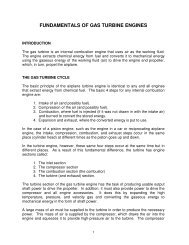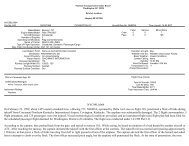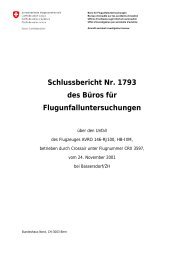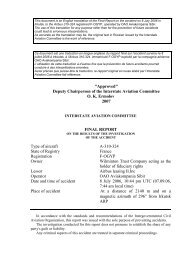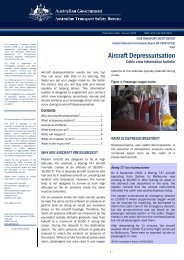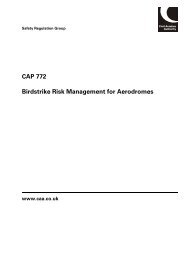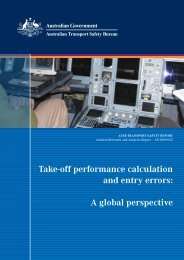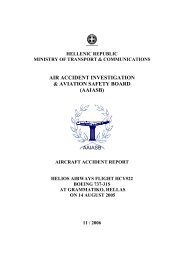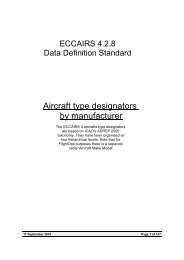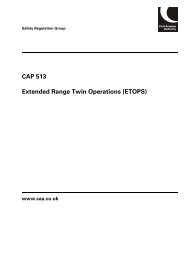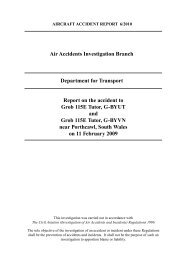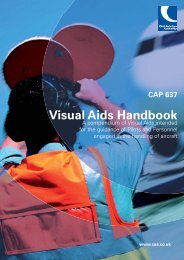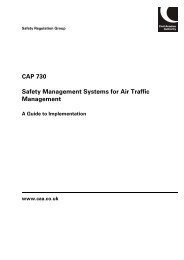Getting the bestout of apW - SKYbrary
Getting the bestout of apW - SKYbrary
Getting the bestout of apW - SKYbrary
You also want an ePaper? Increase the reach of your titles
YUMPU automatically turns print PDFs into web optimized ePapers that Google loves.
FROM THE BRIEFING ROOM<br />
38<br />
<strong>Getting</strong> <strong>the</strong> best out <strong>of</strong> <strong>apW</strong><br />
By Dijana Pasic<br />
Airspace infringements remain one <strong>of</strong> <strong>the</strong> top safety issues.<br />
Whilst eff orts are being made to raise pilots’ awareness in order to<br />
minimise <strong>the</strong> numbers <strong>of</strong> airspace infringements, it is worth<br />
examining whe<strong>the</strong>r <strong>the</strong> ATC ground-based safety nets can play a<br />
better role in alerting controllers about airspace infringements.<br />
In this article, I will look at diff erent<br />
types <strong>of</strong> airspace infringement and<br />
how ATC ground based safety nets can<br />
be improved to provide controllers<br />
with alerts <strong>of</strong> airspace infringements<br />
before <strong>the</strong>y occur.<br />
So what could be done at system<br />
level to reduce airspace infringement<br />
events?<br />
Currently, many ATC ground systems<br />
are equipped with a safety net that<br />
warns controllers in situations when<br />
aircraft are predicted to penetrate or<br />
have already penetrated a designated<br />
airspace volume without clearance.<br />
The airspace volume in question could<br />
be a restricted/danger/prohibited area<br />
or even designated parts <strong>of</strong> controlled<br />
airspace.<br />
This safety net, depending on <strong>the</strong><br />
implementation, is called Area Proximity<br />
Warning (APW), Danger Area Infringement<br />
Warning (DAIW), Restricted<br />
Area Intrusion (RAI) or Controlled<br />
Airspace Infringement Tool (CAIT).<br />
The alert is provided at <strong>the</strong> controller’s<br />
working position and <strong>the</strong> resolution<br />
<strong>of</strong> <strong>the</strong> situation is left entirely to<br />
<strong>the</strong> controller’s decision – <strong>the</strong>re is no<br />
resolution advisory.<br />
The APW can be used to warn controllers<br />
when an aircraft is about to<br />
infringe (or has already infringed) <strong>the</strong><br />
designated airspace area. A typical<br />
example is a civil aircraft penetrating<br />
military airspace, see Figure 1, which<br />
can pose a signifi cant risk to <strong>the</strong> civil<br />
aircraft and additionally to any aircraft<br />
operating within <strong>the</strong> military area.<br />
Area Proximity Warning (APW):<br />
Ground-based safety net intended to warn <strong>the</strong> controller <strong>of</strong> unauthorised penetration into an<br />
airspace airspace volume by generating, in a timely manner, an alert <strong>of</strong> a potential or actual infringement<br />
<strong>of</strong> <strong>the</strong> required spacing to that airspace volume.<br />
Ref: EUROCONTROL Specifi cation for APW. APW. Edition 0.5<br />
Dijana pasic<br />
works at EUROCONTROL HQ as an Operational<br />
Expert, is involved in operational ATC safety net<br />
activities and is an active member <strong>of</strong> SpIN.<br />
She has a background as an approach controller at<br />
Sarajevo airport, Bosnia and Herzegovina.<br />
Ano<strong>the</strong>r concept <strong>of</strong> use <strong>of</strong> this safety<br />
net is to warn controllers when an unauthorised<br />
aircraft is about to infringe<br />
or is already infringing controlled airspace.<br />
A typical example is a VFR fl ight<br />
penetrating controlled airspace or a<br />
military aircraft leaving a military exercise<br />
area without clearance. Although<br />
in <strong>the</strong>se cases <strong>the</strong> controllers probably<br />
do not have two-way communication<br />
with <strong>the</strong> infringing fl ight, suffi cient<br />
warning time can enable <strong>the</strong>m ei<strong>the</strong>r<br />
to act on <strong>the</strong> fl ight under <strong>the</strong>ir control<br />
or to initiate coordination in regards to<br />
<strong>the</strong> infringing fl ight.<br />
Some APW systems provide 2 different<br />
levels <strong>of</strong> alert with a diff erent<br />
display for each level. For example,<br />
when an aircraft is about to penetrate<br />
a restricted area, <strong>the</strong> APW alert at <strong>the</strong><br />
controller’s working position could be<br />
displayed in yellow. When <strong>the</strong> aircraft<br />
has already penetrated <strong>the</strong> restricted<br />
area, <strong>the</strong> APW alert could be displayed<br />
in red - see Figure 1.<br />
How does APW work?<br />
APW uses surveillance data (including<br />
tracked pressure altitude information)<br />
and fl ight plan data to predict any potential<br />
airspace infringements. Ei<strong>the</strong>r<br />
Mode C or Mode S data can be used to<br />
make a prediction in <strong>the</strong> vertical dimension.<br />
Environment data and parameters<br />
are used to defi ne <strong>the</strong> airspace volumes<br />
and <strong>the</strong> parameters for alert delivery.<br />
APW makes use <strong>of</strong> data from:<br />
n <strong>the</strong> fl ight data processing system to<br />
determine which fl ights are eligible<br />
for alert generation using aircraft<br />
type and category <strong>of</strong> fl ight;<br />
n aff ected sectors to display alerts to<br />
all controller working positions concerned;<br />
n cleared /blocked fl ight levels – and<br />
manually entered fl ight levels if altitude<br />
information is not available;
n recorded aircraft RVSM status to determine<br />
<strong>the</strong> defi ned spacing from<br />
<strong>the</strong> airspace volume.<br />
In addition to APW alerts, controllers<br />
are normally provided with information<br />
on <strong>the</strong> availability <strong>of</strong> APW. They<br />
also have <strong>the</strong> option to inhibit APW<br />
alerting for a specific radar track or<br />
group <strong>of</strong> tracks, e.g. one based on<br />
<strong>the</strong> SSR code group.<br />
One <strong>of</strong> <strong>the</strong> most demanding tasks<br />
when improving <strong>the</strong> performance<br />
<strong>of</strong> any safety net is to achieve <strong>the</strong><br />
best balance between <strong>the</strong> length <strong>of</strong><br />
<strong>the</strong> warning time and nuisance alert<br />
rate. Increasing <strong>the</strong> warning time,<br />
depending on <strong>the</strong> conflict geometry,<br />
could create more nuisance alerts.<br />
On <strong>the</strong> o<strong>the</strong>r hand, reducing <strong>the</strong><br />
number <strong>of</strong> nuisance alerts may result<br />
in insufficient warning time or even<br />
lead to some conflicts being missed.<br />
It is definitely not a one-<strong>of</strong>f activity<br />
and it requires a team <strong>of</strong> technical<br />
and operational staff working toge<strong>the</strong>r.<br />
How does APW interact<br />
with o<strong>the</strong>r safety nets?<br />
APW works in conjunction with <strong>the</strong><br />
Short Term Conflict Alert. STCA alerts<br />
controllers in situations <strong>of</strong> potential<br />
or actual infringement <strong>of</strong> separation<br />
minima and so helps prevent collisions<br />
between aircraft, whilst <strong>the</strong><br />
APW does this indirectly by predicting<br />
or detecting unauthorised air-<br />
Figure 1<br />
Defi ning:<br />
<strong>the</strong> initial step <strong>of</strong> <strong>the</strong> lifecycle is <strong>the</strong> defi nition <strong>of</strong> roles and responsibilities (ideally a team that<br />
consist <strong>of</strong> operational, technical and safety experts) inside <strong>the</strong> organisation and <strong>the</strong> defi nition<br />
<strong>of</strong> <strong>the</strong> operational requirements <strong>of</strong> ApW.<br />
Implementing:<br />
next step is taking a decision about <strong>the</strong> ApW procurement. This phase is mostly performed by<br />
engineers and technical experts. System verifi cation is performed ei<strong>the</strong>r when implementing<br />
a new ApW from scratch or when enhancing an existing ApW.<br />
Optimising:<br />
<strong>the</strong> third phase is aimed at optimising <strong>the</strong> system in order to meet <strong>the</strong> operational requirements<br />
identifi ed in <strong>the</strong> fi rst phase. It also addresses validating <strong>the</strong> system before making it<br />
fully operational. This phase relies on close collaboration between technical staff and operational<br />
experts.<br />
Operating:<br />
When ApW is considered to be validated or optimised, adequate training is provided to both<br />
Controllers and engineers. Once ApW is fully operational, a set <strong>of</strong> parallel processes are put<br />
in place: Collection <strong>of</strong> feedback from Controllers, Analysis <strong>of</strong> pilots/Controllers reports, Monitoring<br />
<strong>of</strong> ApW performance and Maintenance. All this requires a close collaboration between<br />
operational and technical staff . Safety experts should also be involved, to ensure that <strong>the</strong> ApW<br />
role is adequately considered in evaluating <strong>the</strong> whole safety performance <strong>of</strong> <strong>the</strong> ANSp.<br />
Ref: EUROCONTROL Guidance Material for ApW. Edition 1.0<br />
space volume penetration. Very <strong>of</strong>ten,<br />
STCA is disabled within airspace<br />
such as restricted/danger/prohibited<br />
areas which are normally protected<br />
by APW so as to reduce <strong>the</strong> nuisance<br />
alert rate. For example, military traffic<br />
flying within a military area could<br />
create a lot <strong>of</strong> STCA nuisance alerts.<br />
In order to still help protect <strong>the</strong> surrounding<br />
traffic, <strong>the</strong> APW is activated<br />
in <strong>the</strong> segregated area and alerts occur<br />
for any departure from or penetration<br />
into that defined airspace<br />
volume.<br />
Why do we need<br />
safety nets?<br />
Even <strong>the</strong> best systems fail. Safety<br />
nets help prevent incidents from developing<br />
into significant incidents or<br />
even accidents, and serve as “ano<strong>the</strong>r<br />
pair <strong>of</strong> eyes”.<br />
Can we improve APW<br />
performance?<br />
Many controllers will have already had<br />
experience <strong>of</strong> APW and have probably<br />
sometimes had questions about its performance.<br />
In order to get <strong>the</strong> best out <strong>of</strong> APW and<br />
improve its performance, it is important<br />
to follow a defi ned lifecycle. The lifecycle,<br />
see Figure 2, represents an ideal process<br />
to be followed by ANSPs to implement<br />
and maintain a satisfactory level <strong>of</strong> APW<br />
protection during normal operations.<br />
The Safety Nets Performance Improvement<br />
Network Sub Group (SPIN) has developed<br />
<strong>the</strong> specifi cation and guidance<br />
material for ground-based safety nets<br />
including Area Proximity Warning (APW).<br />
The documents are available at<br />
www.eurocontrol.int/safety-nets.<br />
Figure 2<br />
Hindsight 11 Summer 2010 39




